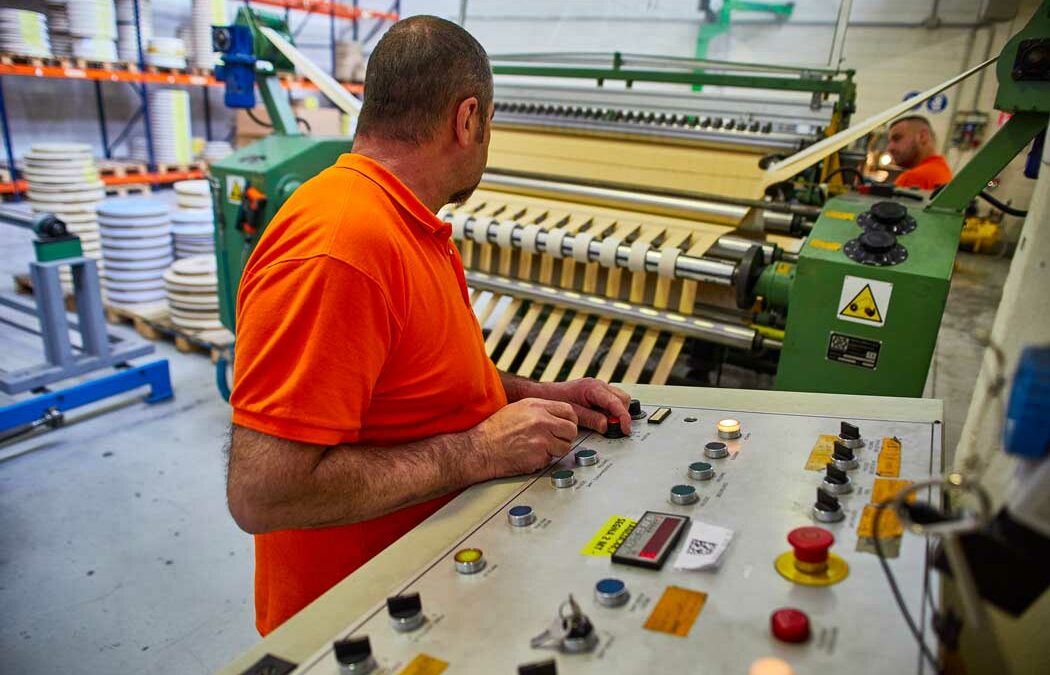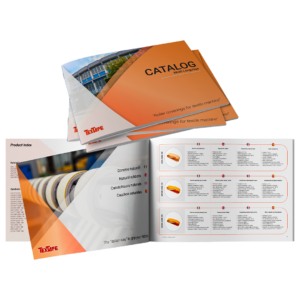So far, in our posts, we mainly focused on the products characteristics, but there are many more things you should know.
This time, specifically, we’d like to talk about:
-
- The production process
- How ideas for new puller belts are born.
Table of Contents
The production process of Textape puller belts
1. Initial phase
Our company has got many different machines located across Italy and Europe. Specifically, we have 7 spreaders for processing rubber, PVC, silicone, and technical felts. The embossing rollers installed on these machines are owned by Textape, and all the pieces are used to produce coated and embossed foils of standard size. These pieces, which we call raw material, measure 100 or 115 meters in length. Then, they cut it into coils, and the items are shipped to our headquarters in Cormano, Italy.

2. The coils reach Cormano.
The coils that reach our Italian facilities are much smaller than the foils in the initial phase, as they are only 1550 mm long. And in Cormano, the material undergoes another downsizing process. At this stage, in particular, we cut it into ribbons. Of course, the sizes are standard, and they are 50 mm,70 mm, or 100 mm.
Is another step required to create puller belts, you ask? It depends on what the customer wants. If our client needs double-sided adhesive items, then yes, the product undergoes another process, which is hot calendering. At this stage, the puller belt is covered with bi-adeshive. To make it, we use a machine we invented ad hoc, which we call calandrina.
It’s time to move on to the shipping department, also located in Cormano. In this office, all products are carefully inspected during quality control. Then, if the team states the coils have passed the test, the products are given a QR code. What does the QR code do? It links the puller belt to our systems. That way, we can keep track of the production batch, the spreader it comes from, the year and month the item was made, etc.
In other words, the QR code is handy when the client calls us to report any product anomalies. In fact, once the customer does it, we can locate all the coils that are part of the same production cycle and check if all of them have the same problem. Once done, we can quickly propose a quick replacement of the faulty components.

3. To shipping!
Finally, boxes containing coils are picked up by our trusted carriers. Products are delivered mainly to specialized dealers with whom we signed exclusive contracts and that are distributed worldwide.
How the idea takes form
At the moment, the Textape catalog features 90 products. How do we create new items? It all begins with the requests of textile machinery makers. After all, these figures know best what should be installed on the equipment they sell.
When makers get in touch with us, they immediately provide the technical project of the machinery. But the drawing is not sufficient to make new items. To start creating the perfect puller belt, in particular, we need the following data:
-
- The temperature the machines can reach;
- Whether the textile processes involve using steam;
- Whether the machine uses solvents or particular dyes;
- The weight the covering must bear;
- Which fabrics is the puller belt intended for. Do they process nylon, polyester, or cotton? This information is essential because textile fibers have an abrasion power and can “eat” the covering. This power, though, varies from fabric to fabric, so if one consumes the coating quickly, another might do so in more time.
In addition, we need info on the backing. For instance, which material does the client prefer, polyester or cotton? Also, should the puller belt feature self-adhesive support, or does the client prefer something that has to be installed using glue?
Actually, we think we could answer the last question ourselves. In fact, our business is structured as follows:
-
- 40% self-adhesive products;
- 60% non-adhesive items.
At Textape, we also sell tools for installing the components. In our catalog, you can find a special glue designed for installing puller belts on your machinery rollers. It’s a product with a 15 -year-long history which allows you to stick the puller belts in perfect adherence to your equipment. The code of this glue is 310, and the product is available in 1 kg packages and 4 kg drums.

Where we ship our puller belts?
In the mid-1990s, we decided to start investing in export. We began with countries like Chile and New Zealand, but, in time, we registered more and more enthusiasm for our products. Thus, we decided to expand our network little by little. Today we export to all 6 continents and goods are delivered in 3 working days.
Our top-seller products
As we mentioned above, at the moment, in Textape, we feature 90 products, all of which originated from the need of textile manufacturers. Each piece has its buyers, but some puller belts sell more than others. Would you like to know what our workhorses are? Here they are:
-
- Medium granulated rubber + PVC;
- Grindered synthetic rubber;
- Nylon + green PVC;
- Synthetic rubber fabric;
- Silicone impressed cloth;
- Grindered synthetic elastic rubber;
- White silicone flat surface;
- PVC + three reliefs.
Wrapping up
Are you looking for a particular product for your machines that you can’t find in our catalog? We can make custom puller belts expressly for you. Get in touch with us and let us know your needs.


